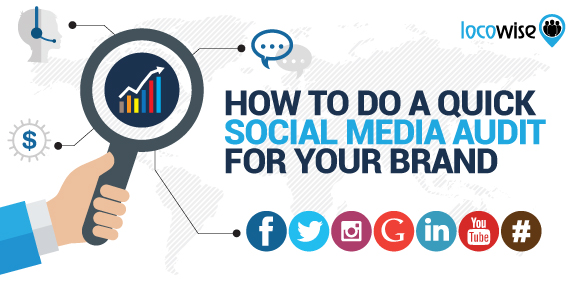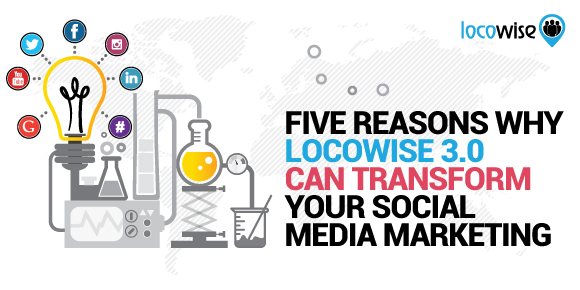How To Do A Quick Social Media Audit For Your Brand
Sahail Ashraf posted on 4 July 2016
So you have a ton of social media profiles for your brand and everything is starting to go pretty smoothly. Or so it seems. Niggling questions start to surface about the effectiveness of what you are doing. With so much going on, it’s all getting out of control.
It’s time for a social media audit. Carrying out an audit will allow you to organise your social media work. You’ll know what is working and what isn’t, and you’ll (most importantly) be able to use the information you gather to create better content in the right places.
And if you’re particularly thorough (and honest) during the audit, you’ll probably get rid of a lot of time sinks.

HOW TO START
There is no specific place to start, but it’s generally accepted that one of the very best starting points is a look at your metrics. You need to get to know them inside out. Your data will tell you everything about what works and what stinks when it comes to your social media. So your first port of call in that social media audit is some time spent with your data.
Data will show you the info on each aspect of your work. You’ll see info about reach and engagement, both of platforms and content itself. This is crucial, because the more you get to find out, the more informed your decisions are when it comes to pursuing content themes and content strategies.
Take time to understand the metrics side of things and everything becomes a little clearer.

CONSISTENCY
You next need to focus on your various profiles and make sure the hymn sheet they are using is the same. This is a vital aspect because so many brands right now are still stuck with profiles that are vastly different to each other.
Is your Twitter profile the same in tone and branding as your Instagram? They don’t need to be clones, but they should offer the same brand feel. And while we’re at it and you’re looking at your profiles, make sure that they are all filled out to the max.
There is nothing worse than finding a brand’s social media profiles and then discovering that the profiles themselves are incomplete. It smacks of unprofessionalism, and also a distinct lack of care when it comes to the audience. As part of your audit, check all your profiles for completeness. It takes minutes to fill most of them out, so there is no excuse.
Branding is absolutely possible on social media, so the consistency is important. Take a good look at all of your profiles. Even if the profiles differ a little in tone, your audience should be able to instantly work out what your brand is saying, wherever you are. If that branding isn’t clear, change it.

GET FOCUSED
Once you have a handle on some of the metrics, and you have cleaned out the rubbish when it comes to presentation and profile completeness, it’s time to get focused on a few goals. It’s easy to just post every day or every hour and expect that to bring you results, but without a clear set of goals you aren’t going to get anywhere.
The easiest goal? That’s simple: fan base growth. Take a look at Twitter today and then set out a goal for an increased number of followers by next month. Or look at your Instagram page and do the same. This is one of the easiest targets to set because it is all about the numbers.
And if you really want to get a handle on how your Twitter, Instagram or Facebook audience might grow, check out the Locowise growth prediction charts. You’ll find them in the Social Scientist section of your Locowise account.

But hey, switch it up a little and look at engagement too. If you want to get the very best out of your social media profiles, part of your audit should involve setting goals for engagement. You’re looking here at any kind contact or involvement with what you do. If your tweets get retweeted, that is a form of engagement. So you set a goal for an increase in the number of retweets, for example.
If you are rocking it on Instagram, the number of likes you get is a good indicator of engagement. So are comments. The more people start to respond and essentially interact with what you do, the more engagement you have. Cranking up your profiles by setting goals of engagement can be an excellent byproduct of an audit.
Create a social media report with all these metrics. Review it regularly to monitor your performance towards reaching your goals.
GET THE GOOD STUFF DONE AGAIN, AND AGAIN
If you find, during your audit, that some posts get a ton more engagement than others, then you have a very powerful tool at your fingertips.
Finding stuff that gets more joy from the audience you have means that you are then able to simply reproduce it.
We don’t mean make a carbon copy of what you do and then go off and play that round of golf.
Instead, we mean making a note of which types of content and topics work, and then creating more of the same.

CURB THE BIG, WASTEFUL SPEND
Perhaps the biggest problem here for many brands is the link between engagement and spending. If you are actually spending money on promoting posts, and you can’t see (during the audit) engagement increase that is proportionate to spending, then you are wasting money. The audit can tell you this, and engagement is, therefore, a huge part of your knowledge gathering process.
You may, of course, find that some spending is making a difference, that’s the other side of the coin. But carrying out an audit gives you that coin in the first place. If you can see that expenditure every month brings you great results, then you know that your money is going in the right places. Play around with it, and check your data against spending over certain periods. The answers will be clear soon enough.
CHEAT SHEET STUFF
If you use Locowise, you can hit the ‘Content’ section at the top of the home screen, and filter out the content so that you only see the best performing stuff or the worst. Cross match that against what you’re paying for in our Facebook Advertising section, and you have the ROI answers you need.
Take your brand down the route outlined above and you should be a little leaner and meaner. You should be able to identify which content works best. You should have tidied up your profiles and made them brand-true. You should also be on top of your spending, to the extent that you know exactly which content brings you some ROI and what simply doesn’t.





